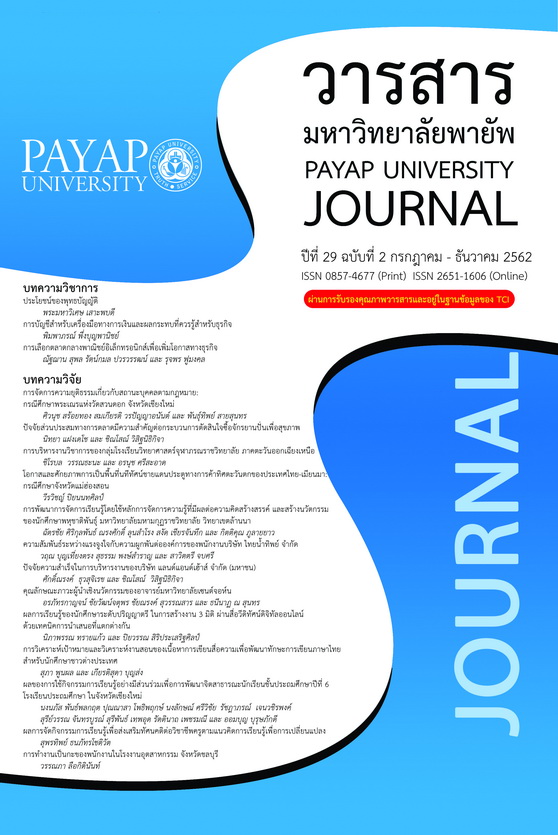Learning Achievements of Undergraduate Students on the Creation of 3D Task through Online Digital Video with Different Presentation Techniques
Main Article Content
Abstract
This research aimed to study and compare learning achievements on the 3D task creation of undergraduate students in Mae Jo University when using conventional and special online digital video technique. 60 Mae Jo University, undergraduate students were obtained by purposive random sampling, systematic random sampling and random assignment technique. Data was collected using test and questionnaire. Data collection was performed by researcher. Analyzed data was reported as frequency, percentage, arithmetic mean, and standard deviation. Significant difference between groups was analyzed using t-test. The results remarked that (1) most sample were female, 19 years old, having an experience in illustrator program, but have no experience in 3D creation using illustrator program, and (2) the conventional technique gave significantly difference in knowledge, understanding, and implementation comparing to special technique (p<0.05), but (3) satisfaction on 3D creation content of undergraduate students was not significantly different in both groups (p>0.05), and (4) 3D creation skill was not significantly different in both groups (p>0.05).
Article Details
References
__________. (2548). เทคโนโลยีและการสื่อสารเพื่อการศึกษา. กรุงเทพฯ: อรุณการพิมพ์.
ชัยวัฒน์ สุทธิรัตน์. (2552). 80 นวัตกรรมการจัดการเรียนรู้ที่เน้นผู้เรียนเป็นสำคัญ. กรุงเทพฯ: แดแน็กซ์ อินเตอร์คอร์ปปอเรชั่น.
ถนอมพร (ตันพิพัฒน์) เลาหจรัสแสง. (2545). Designing e-Learning หลักการออกแบบและการสร้างเว็บเพื่อการเรียนการสอน. เชียงใหม่: มหาวิทยาลัยเชียงใหม่.
บุปผชาติ ทัฬหิกรณ์, สุกรี รอดโพธิ์ทอง, ชัยเลิศ พิชิตพรชัย และโสภาพรรณ แสงศัพท์. (2544). ความรู้เกี่ยวกับสื่อมัลติมีเดียเพื่อการศึกษา. กรุงเทพฯ: คุรุสภาลาดพร้าว.
พิชญาพร ประครองใจ และเอกรงค์ ปั้นพงษ์. (2559). ความพึงพอใจของนักศึกษาหลักสูตรนิเทศศาสตรบัณฑิต ที่มีต่อการใช้สื่อการสอนของอาจารย์สาขาวิชานิเทศศาสตร์ คณะวิทยาการจัดการ มหาวิทยาลัยราชภัฏพิบูลสงคราม. วารสารมนุษยศาสตร์และสังคมศาสตร์ บัณฑิตวิทยาลัยมหาวิทยาลัยราชภัฏพิบูลสงคราม, 10(2), 55-65.
ภควิชญ์ ดำรงเกียรติศักดิ์. (2555). ผลสัมฤทธิ์การเรียนรู้ผ่านสื่อมัลติมีเดียแบบมีปฏิสัมพันธ์ที่มีเทคนิคการบรรยายต่างกัน. วารสารวิชาการ มหาวิทยาลัยฟาร์อีสเทอร์, 6(1), 79-87.
มหาวิทยาลัยสุโขทัยธรรมาธิราช. (2543). ความรู้เบื้องต้นเกี่ยวกับภาพนิ่งและภาพยนตร์. นนทบุรี: มหาวิทยาลัยสุโขทัยธรรมาธิราช.
วิทยา ดำรงเกียรติศักดิ์. (2559). ความฉลาดทางดิจิทัล, สืบค้นเมื่อ 25 กันยายน 2559. http://www.infocommmju.com/icarticle/images/stories/icarticles/ajwittaya/Digital_Quotient1.pdf.
หริพล ธรรมนารักษ์. (2558). นวัตกรรมและเทคโนโลยีสารสนเทศทางการศึกษายุคดิจิทัล. กรุงเทพฯ: ทริปเพิ้ลกรุ๊ป.


